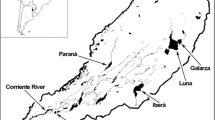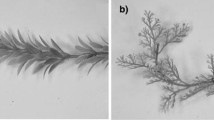Abstract
Environmental heterogeneity in natural ecosystems influences several parameters at the population and community levels. In freshwater ecosystems, habitat heterogeneity can be provided by macrophyte species with different structural shapes. Previous studies suggest that aquatic plants with more complex architectures will support higher number, biomass, and taxon richness of macroinvertebrates than plants with simpler shape. We investigated the influence of macrophyte structural heterogeneity (quantified by fractal dimension) and food availability (represented by epiphytic biomass) on several parameters (number of individuals, biomass, body size distribution, taxon richness, and diversity) of the macroinvertebrate community in a Pampean stream. Four submerged macrophyte species (Egeria densa, Elodea ernstae, Ceratophyllum demersum, and Stuckenia striata) and associated macroinvertebrates were sampled in late spring, summer, and autumn. Plants were photographed and fractal dimension was estimated from the images by the box-counting method. Fractal dimension was independent of plant surface area per unit of macrophyte biomass and differed significantly among species. Mean fractal dimension varied between 1.29 and 1.62, and increased following the sequence E. densa → S. striata → E. ernstae → C. demersum. Macrophyte species with higher fractal dimension supported a greater abundance of macroinvertebrates, especially those of small body size (500–1,000 μm); but fractal dimension was unrelated to macroinvertebrate biomass, richness, and diversity. However, overall animal biomass was significantly associated to the epiphytic abundance. Consequently, macrophyte heterogeneity influences macroinvertebrate density and body size distribution, while animal biomass depends on epiphytic food resources provided by plants.




Similar content being viewed by others
References
APHA, 1995. Standard methods for the examination of water and wastewater. American Public Health Association Inc., Washington, DC.
Attrill, M., J. Strong & A. Ashley, 2000. Are macroinvertebrate communities influenced by seagrass structural complexity? Ecography 23: 114–121.
Barbour, M., J. Gerritsen, B. Snyder & J. Stribling, 1999. Rapid bioassessment protocols for use in streams and wadeable rivers: periphyton, benthic macroinvertebrates and fish, 2nd edn. EPA 841–B99002. U.S. Environmental Protection Agency, Office of Water, Washington, DC.
Brown, C., T. Poe, J. French III & D. Schloesser, 1988. Relationships of phytomacrofauna to surface area in naturally occurring macrophyte stands. Journal of the North American Benthological Society 7: 129–139.
Cattaneo, A. & J. Kalff, 1980. The relative contribution of aquatic macrophytes and their epiphytes to the production of macrophytes beds. Limnology and Oceanography 25: 280–289.
Cheruvelil, K., P. Soranno & R. Serbin, 2000. Macroinvertebrates associated with submerged macrophytes: sample size and power to detect effects. Hydrobiologia 441: 133–139.
Cheruvelil, K., P. Soranno, J. Madsen & M. Roberson, 2002. Plant architecture and epiphytic macroinvertebrate communities: the role of an exotic dissected macrophyte. Journal of the North American Benthological Society 21: 261–277.
Clench, H., 1979. How to make regional lists of butterflies: some thoughts. Journal Lepidopterist’s Society 33: 216–321.
Colwell, R.K., 2006. EstimateS: Statistical estimation of species richness and shared species from samples, version. Version 8. Persistent URL. purl.oclc.org/estimates.
Connor, E. & E. McCoy, 1979. The statistics and biology of the species-area relationship. American Naturalist 113: 791–833.
Cooper, S., L. Barmuta, O. Sarnelle, K. Kratz & S. Diehl, 1997. Quantifying spatial heterogeneity in streams. Journal of the North American Benthological Society 16: 174–188.
Cremona, F., D. Planas & M. Lucotte, 2008. Biomass and composition of macroinvertebrate communities associated with different types of macrophyte architectures and habitats in a large fluvial lake. Fundamental and Applied Limnology 171: 119–130.
Cyr, H. & J. Downing, 1988. The abundance of phytophilous invertebrates on different species of submerged macrophytes. Freshwater Biology 20: 365–374.
Di Marzio, W., M. Tortorelli & L. Freyre, 2003. Diversidad de peces en un arroyo de llanura. Limnetica 22: 71–76.
Dibble, E. & S. Thomaz, 2009. Use of fractal dimension to assess habitat complexity and its influence on dominant invertebrates inhabiting tropical and temperate macrophytes. Journal of Freshwater Ecology 24: 93–102.
Dionne, M. & C. L. Folt, 1991. An experimental analysis of macrophyte growth forms as fish foraging habitat. Canadian Journal of Fisheries and Aquatic Sciences 48: 123–131.
Feijoó, C. & R. Lombardo, 2007. Baseline water quality and macrophytes assemblages in Pampean streams: a regional approach. Water Research 41: 1399–1410.
Gee, J. & R. Warwick, 1994. Metazoan community structure in relation to the fractal dimension of marine macroalgae. Marine Ecology Progress Series 103: 150–151.
Giorgi, A., C. Feijoó & G. Tell, 2005. Primary producers in a Pampean stream: temporal variation and structuring role. Biodiversity and Conservation 14: 1699–1718.
Gotelli, N. J. & R. K. Colwell, 2001. Quantifying biodiversity: procedures and pitfalls in the measurement and comparison of species richness. Ecology Letters 4: 379–391.
Gregg, W. & F. Rose, 1982. The effects of aquatic macrophytes on the stream microenvironment. Aquatic Botany 14: 309–324.
Gross, E., D. Erhard & E. Ivanyi, 2003. Allelopathic activity of Ceratophyllum demersum L. and Najas marina ssp. intermedia (Wolfgang) Casper. Hydrobiologia 506: 583–589.
Halley, J., S. Hartley, A. Kallimanis, W. Kunin, J. Lennon & S. Sgardelis, 2004. Uses and abuses of fractal methodology in ecology. Ecology Letters 7: 254–271.
Hauser, A., M. Attrill & P. Cotton, 2006. Effects of habitat complexity on the diversity and abundance of macrofauna colonizing artificial kelp holdfasts. Marine Ecology Progress Series 325: 93–100.
Heck, K. & L. Crowder, 1991. Habitat structure and predator-prey interactions in vegetated aquatic systems. In Bell, S., E. McCoy & H. Mushinsky (eds), Habitat structure: the physical arrangement of the objects in space. Chapman and Hall, London: 281–299.
Hutchens J. Jr., J. Wallace & E. Romaniszyn, 2004. Role of Podostemum ceratophyllum Michx. in structuring benthic macroinvertebrate assemblages in a southern Appalachian river. Journal of the North American Benthological Society 23: 713–727.
Jeffries, M., 1993. Invertebrate colonization of artificial pondweeds of differing fractal dimension. Oikos 67: 142–148.
MacArthur, R. H., 1965. Patterns of species diversity. Biological Review 40: 510–533.
MacArthur, R. H. & J. W. Mac Arthur, 1961. On bird species diversity. Ecology 42: 594–598.
McAbendroth, L., P. Ramsay, A. Foggo, S. Rundle & D. Bilton, 2005. Does macrophyte fractal complexity drive invertebrate diversity, biomass and body size distributions? Oikos 111: 279–290.
McEwen, G., M. Johnson & T. Folsom, 1994. A statistical analysis of the performance of the folsom plankton sample splitter, based upon test observations. Meteorology and Atmospheric Physics 7: 502–527.
Morse, D., J. Lawton, M. Dodson & M. Williamson, 1985. Fractal dimension of vegetation and the distribution of arthropod body length. Nature 314: 731–733.
Padial, A., S. Thomaz & A. Agostinho, 2009. Effects of structural heterogeneity provided by the floating macrophyte Eichhornia azurea on the predation efficiency and habitat use of the small Neotropical fish Moenkhausia sanctaefilomenae. Hydrobiologia 624: 161–170.
Rasband, W., 1997–2008. ImageJ. U.S. National Institutes of Health, Bethesda, Maryland. http://rsb.info.nih.gov/ij/.
Robson, B., L. Barmuta & P. Fairweather, 2005. Methodological and conceptual issues in the search for a relationship between animal body-size distributions and benthic habitat architecture. Marine and Freshwater Research 56: 1–11.
Russo, A., 1990. The role of seaweed complexity in structuring Hawaiian epiphytal amphipod communities. Hydrobiologia 194: 1–12.
Sokal, R. & F. Rohlf, 1995. Biometry: the principles and practice of statistics in biological research. W. H. Freeman and Co, New York.
Stewart, T., T. Shumaker & T. Radzio, 2003. Linear and nonlinear effects of habitat structure on composition and abundance in the macroinvertebrate community of a large river. American Midland Naturalist 149: 293–305.
Sugihara, G. & R. May, 1990. Application of fractals in ecology. Trends in Ecology & Evolution 5: 79–86.
Taniguchi, H., S. Nakato & M. Tokeshi, 2003. Influences of habitat complexity on the diversity and abundance of epiphytic invertebrates on plants. Freshwater Biology 48: 718–728.
Tessier, C., A. Cattaneo, B. Pinel-Alloul, C. Hudon & D. Borcard, 2008. Invertebrate communities and epiphytic biomass associated with metaphyton and emergent and submerged macrophytes in a large river. Aquatic Sciences 70: 10–20.
Thomaz, S., E. Dibble, L. Evangelista, J. Higuti & L. Bini, 2008. Influence of aquatic macrophyte habitat complexity on invertebrate abundance and richness in tropical lagoons. Freshwater Biology 53: 358–367.
Warfe, D. & L. Barmuta, 2004. Habitat structural complexity mediates the foraging success of multiple predator species. Oecologia 141: 171–176.
Warfe, D. & L. Barmuta, 2006. Habitat structural complexity mediates food web dynamics in a freshwater macrophyte community. Oecologia 150: 141–154.
Warfe, D., L. Barmuta & S. Wotherspoon, 2008. Quantifying habitat structure: surface convolution and living space for species in complex environment. Oikos 117: 1764–1773.
Williamson, M. & J. Lawton, 1991. Fractal geometry of ecological habitats. In Bell, S., E. McCoy & H. Mushinsky (eds), Habitat structure: the physical arrangement of the objects in space. Chapman and Hall, London: 69–86.
Acknowledgments
The authors are grateful to Fernando Momo for valuable discussion in the early steps of the study and Rafael Marcé for their useful comments on the manuscript. We also thank Santiago Doyle for his contribution to the development of the fractal dimension estimation technique, Matias Eöry for providing previous field data, the landowner and the manager of Santa María del Arroyo farm for providing access to the study site, María Andrea Casset, Analía Álvarez, and Patricia Aoki for field and laboratory assistance, and Mary Eve Coviella for the revision of the English text. The manuscript was improved by the suggestions and comments of the editor and two reviewers. This project was supported by the Universidad Nacional de Luján.
Author information
Authors and Affiliations
Corresponding author
Additional information
Handling editor: Nuria Bonada
Rights and permissions
About this article
Cite this article
Ferreiro, N., Feijoó, C., Giorgi, A. et al. Effects of macrophyte heterogeneity and food availability on structural parameters of the macroinvertebrate community in a Pampean stream. Hydrobiologia 664, 199–211 (2011). https://doi.org/10.1007/s10750-010-0599-7
Received:
Revised:
Accepted:
Published:
Issue Date:
DOI: https://doi.org/10.1007/s10750-010-0599-7




